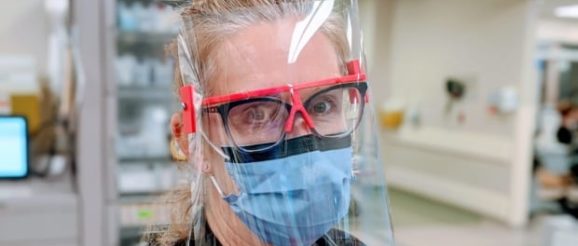How the COVID-19 pandemic is ‘driving innovation’ in Canada and around the world | CBC News

Around the world, people are finding new ways to fight the novel coronavirus pandemic and protect those on the front lines.
Joelle Foster, the chief executive officer of North Forge, a Winnipeg-based tech company, says the people in Manitoba should be learning from these creative approaches.
“If you look at anything that has been eradicated — viruses, pandemics, it’s all come around innovation, whether it’s medical or physical. That’s what has moved our world forward and has put us in such a position that we can live the lives that we now do,” Foster said.
“Without innovation, we’d still be living in the dark ages.”
Jason Kindrachuk, an associate professor at the University of Manitoba and Canada research chair in emerging viruses, says the pandemic is bringing people from different fields together — and that’s a good thing.
“What we have is a crisis that’s driving the merger of different disciplines to come up with really quick solutions to very complex problems,” he said.
Here are just a few of the ways individuals and companies are tackling these complex problems.
Delegating tasks
In response to a need in Alberta, University of Calgary medical students were tapped to connect with people who have come in contact with someone who tested positive for COVID-19.
That means public health officials are able to identify people who are sick, get them medical care and help people take action to protect others.
The help from these medical students quadrupled the province’s capacity to do contact tracing.
Other countries that have done this, including South Korea, Japan and Singapore, have been able to slow the spread in their communities.
Pharmacists in Alberta are also being paid to test people for COVID-19.
Kindrachuk says jurisdictions should be doing more to tap into communities that are already equipped to do testing and research to reduce backlog in returning test results to people.
“It just simply does not make sense not to,” he said.
Making personal protective equipment
Masks, gowns and other personal protective equipment are in short supply all over the world, so some people are taking it upon themselves to fill that need.
Dr. Tarek Loubani, a London, Ont., emergency room doctor, is using equipment from his medical supplies charity to make 3D-printed face shields from plastic, Mylar and elastic for his colleagues in Canada.
Hundreds can be printed at a time.
The shield covers the whole face, protecting the nose and eyes from droplets that may contain the coronavirus which causes COVID-19.
Kindrachuk says personal protective equipment like face shields are “critically important.”
“We have to be concerned about our health-care workers whether they’re physicians or respiratory therapists or nurses or even janitorial staff being protected from anything that could potentially infect them.”
Other businesses are working to fill that need too.
Changing business directions to meet needs
Bauer, the hockey equipment manufacturing company, is shifting its business model to meet medical equipment needs.
It’s been given the green light by the government to make full-face, single-use masks for medical staff and first responders.
Bauer is also in the process of developing visors that can be cleaned, disinfected and reused.
Dyson is also talking about making the leap from vacuums to ventilators.
The British government ordered 10,000 ventilators from the company to help deal with the rising numbers of patients with COVID-19.
And Canada Goose, well known for its pricey but warm coats, is making scrubs and patient gowns for hospitals in light of the shortages.
“That’s what we need right now,” Foster says.
Investing in research
A lab in Saskatoon has been researching and trying to come up with a vaccine for coronaviruses for nearly 40 years, but just lately got $23 million from the federal government.
The Vaccine and Infectious Disease Organization – International Vaccine Centre (VIDO-InterVac) at the University of Saskatchewan started as a veterinary lab in 1975.
It’s evolved to a point that it’s now developing a pan-coronavirus vaccine for human use.
Kindrachuk, who spent time researching at the VIDO-InterVac lab, says it makes sense to invest in people who have experience working in the field during a crisis like this.
“I think it helps to inject some money into a system, look at all that could be built upon it, and hopefully help us prepare for the future,” he said.
A disease research organization based out of Washington University’s St. Louis School of Medicine is asking people to share their unused computer power to help fight COVID-19.
Folding@home is a distributed computing project for disease research. Volunteers contribute their unused computing power to help research potential treatments for various diseases, including the novel coronavirus.
It brings together “citizen scientists” who volunteer to run simulations of protein dynamics on their computers when they’re idling. From there, the data helps scientists better understand the complex biology, and provides new opportunities for developing therapeutics.
According to Kindrachuk, necessity is indeed the mother of invention.
“Ultimately, [COVID-19] is driving innovation,” Kindrachuk says.
“What we’re seeing very quickly is this impetus to get different really smart, talented people together that maybe normally wouldn’t work together, coming together to come up with some really smart solutions.”
